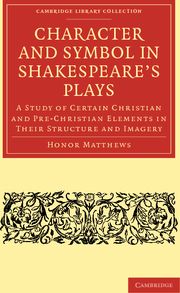 Character and Symbol in Shakespeare's Plays
Character and Symbol in Shakespeare's Plays Published online by Cambridge University Press: 07 September 2010
After Measure for Measure, although a trial may still appear as a muted theme in situation, as when Lear arraigns Goneril and Regan, or in imagery, as when Macbeth imagines even-handed justice commending his poisoned chalice to his own lips, Shakespeare puts aside the simple symbolism so effective in the long development of the Débat du Paradis and illuminates man's concern with justice and mercy by other means. It appears to be significant that he abandons the structure so strongly associated with the religious drama at the very moment when his own plays become most numinous in quality. The Christian tradition in which his thought is rooted is centred in the polarity between fear and love. These are the values that the ‘machiavel’, Richard, explicitly denies:
I, that have neither pity, love, nor fear,
3 Henry VI, v, vi, 68and which Shakespeare never abandons. The necessary fear of evil and of its just punishment is as genuine in The Tempest as in Richard III and only less powerful than the love which finally transcends it. Nevertheless, the melting of the old imagery in the white heat of the later tragedies is no coincidence, for it can be shown that Shakespeare finally indicates a resolution of the paradox of Justice and Mercy in non-dogmatic terms. Before this is discussed, however, it is necessary to consider the subordinate but relevant theme of false-seeming and its power to deceive and destroy.
In the Ludus Coventriae, Misericordia, in her plea for man, said to her sister Justicia:
Ye must consider the frailness of mankind;
Learn and ye list, this is God's love;
Parliament of Heaven, 11. 110–11To save this book to your Kindle, first ensure [email protected] is added to your Approved Personal Document E-mail List under your Personal Document Settings on the Manage Your Content and Devices page of your Amazon account. Then enter the ‘name’ part of your Kindle email address below. Find out more about saving to your Kindle.
Note you can select to save to either the @free.kindle.com or @kindle.com variations. ‘@free.kindle.com’ emails are free but can only be saved to your device when it is connected to wi-fi. ‘@kindle.com’ emails can be delivered even when you are not connected to wi-fi, but note that service fees apply.
Find out more about the Kindle Personal Document Service.
To save content items to your account, please confirm that you agree to abide by our usage policies. If this is the first time you use this feature, you will be asked to authorise Cambridge Core to connect with your account. Find out more about saving content to Dropbox.
To save content items to your account, please confirm that you agree to abide by our usage policies. If this is the first time you use this feature, you will be asked to authorise Cambridge Core to connect with your account. Find out more about saving content to Google Drive.